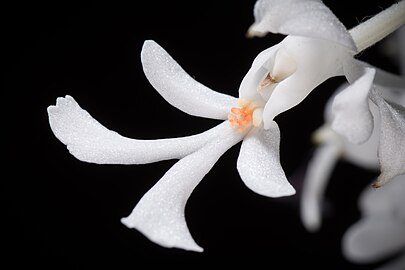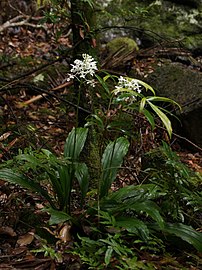Calanthe triplicata
| Common Christmas orchid | |
|---|---|

| |
| Scientific classification | |
| Kingdom: | Plantae |
| Clade: | Tracheophytes |
| Clade: | Angiosperms |
| Clade: | Monocots |
| Order: | Asparagales |
| Family: | Orchidaceae |
| Subfamily: | Epidendroideae |
| Genus: | Calanthe |
| Species: | C. triplicata
|
| Binomial name | |
| Calanthe triplicata | |
| Synonyms[1] | |
|
List of synonyms
| |
Calanthe triplicata commonly known as the common Christmas orchid[2] is a plant in the orchid family and is native to Oceania, Asia, Pacific islands, and the islands of eastern Africa. It is a terrestrial orchid that grows in clumps with crowded pseudobulbs, dark green corrugated leaves and up to forty white flowers. The sepals and petals are similar to each other and the labellum has three spreading lobes and a yellow callus.
Description[edit]
Calanthe triplicata is a terrestrial, evergreen herb that grows in clumps and has crowded, fleshy, oval pseudobulbs 40–80 mm (2–3 in) long and 20–40 mm (0.8–2 in) wide. Each pseudobulb has between four and nine dark green, lance-shaped, corrugated leaves 250–900 mm (10–40 in) long and 60–180 mm (2–7 in) wide tapering towards the base. The leaf veins are more or less parallel with between six and nine more prominent than the rest. Between eighteen and forty white flowers 25–35 mm (0.98–1.4 in) wide are crowded near the top of an upright flowering stem 50–1,500 mm (2–60 in) long. The sepals are egg-shaped, 6–19 mm (0.2–0.7 in) long and 6–7 mm (0.2–0.3 in) wide. The petals are a similar shape, 5–15 mm (0.2–0.6 in) long and 2–6 mm (0.08–0.2 in) wide. The labellum has three widely spreading lobes 4–15 mm (0.2–0.6 in) long and 2–6 mm (0.08–0.2 in) wide with the middle lobe further divided into two. The spur behind the labellum is 10–30 mm (0.4–1 in) long and curved. Flowering occurs from October to February in Australia and in April and May in China.[2][3][4][5]
Taxonomy and naming[edit]
The common Christmas orchid was first formally described in 1796 by (Pierre) Remi Willemet, who gave it the name Orchis triplicata and published the description in Paul Usteri's book Annalen der Botanick.[6][7] In 1907, Oakes Ames changed the name to Calanthe triplicata.[1] The specific epithet (triplicata) is derived from the Latin prefix tris meaning "thrice"[8]: 798 and plicatus meaning "folded".[8]: 619
Distribution and habitat[edit]
Calanthe triplicata is found in Mauritius, Madagascar, Seychelles, Assam, eastern Himalayas, southern India, Sri Lanka, Myanmar, Thailand, Malaysia, Laos, Cambodia, south China, Vietnam, Borneo, Java, Lesser Sunda Islands, Moluccas, Philippines, Sulawesi, Sumatra, Bismark Islands, New Guinea, Solomon Islands, Australia, Fiji, New Caledonia, Samoa, Vanuatu, Wallis and Futuna, Marquesas, Santa Cruz Islands, Caroline Islands, the Marianas Islands, Taiwan, Ryukyu Islands. In Australia it occurs between the Iron Range in Queensland and the Illawarra in New South Wales as well as on Norfolk Island and Lord Howe Island. It grows in evergreen broad-leaved forests, rainforests and other wet forests in dense shade.[1][3][5]
Gallery[edit]
-
Labellum detail
-
Illustration by Lewis Roberts
-
Habit near Binna Burra
-
Labelled image
References[edit]
- ^ a b c d "Calanthe triplicata". World Checklist of Selected Plant Families (WCSP). Royal Botanic Gardens, Kew.
- ^ a b Jones, David L. (2006). A complete guide to native orchids of Australia including the island territories. Frenchs Forest, N.S.W.: New Holland. pp. 353–354. ISBN 1877069124.
- ^ a b Weston, Peter. "Calanthe triplicata". Royal Botanic Gardens Sydney. Retrieved 9 September 2018.
- ^ F.A.Zich; B.P.M.Hyland; T.Whiffen; R.A.Kerrigan (2020). "Calanthe triplicata". Australian Tropical Rainforest Plants Edition 8 (RFK8). Centre for Australian National Biodiversity Research (CANBR), Australian Government. Retrieved 3 June 2021.
- ^ a b Ji Lan, San Zhe Xia. "Calanthe triplicata". Flora of China. pp. 301–302. Retrieved 9 September 2018.
- ^ "Orchis triplicata". World Checklist of Selected Plant Families (WCSP). Royal Botanic Gardens, Kew.
- ^ Usteri, Paul (1796). "Annalen der Botanick". Neue Annalen der Botanick1794-1800. Leipzig: 52. Retrieved 9 September 2018.
- ^ a b Brown, Roland Wilbur (1956). The Composition of Scientific Words. Washington, D.C.: Smithsonian Institution Press.
- Calanthe
- Orchids of Asia
- Orchids of Oceania
- Orchids of Malaya
- Orchids of Assam
- Orchids of Myanmar
- Orchids of Borneo
- Orchids of Cambodia
- Orchids of China
- Orchids of India
- Orchids of Japan
- Orchids of Java
- Orchids of Laos
- Orchids of Madagascar
- Orchids of Malaysia
- Orchids of New Caledonia
- Orchids of New Guinea
- Orchids of New South Wales
- Orchids of the Philippines
- Orchids of Queensland
- Orchids of Sumatra
- Orchids of Sri Lanka
- Orchids of Taiwan
- Orchids of Thailand
- Orchids of Vietnam
- Flora of Fiji
- Flora of Mauritius
- Flora of the Ryukyu Islands
- Flora of Seychelles
- Flora of Samoa
- Flora of Sulawesi
- Flora of Vanuatu
- Plants described in 1796




